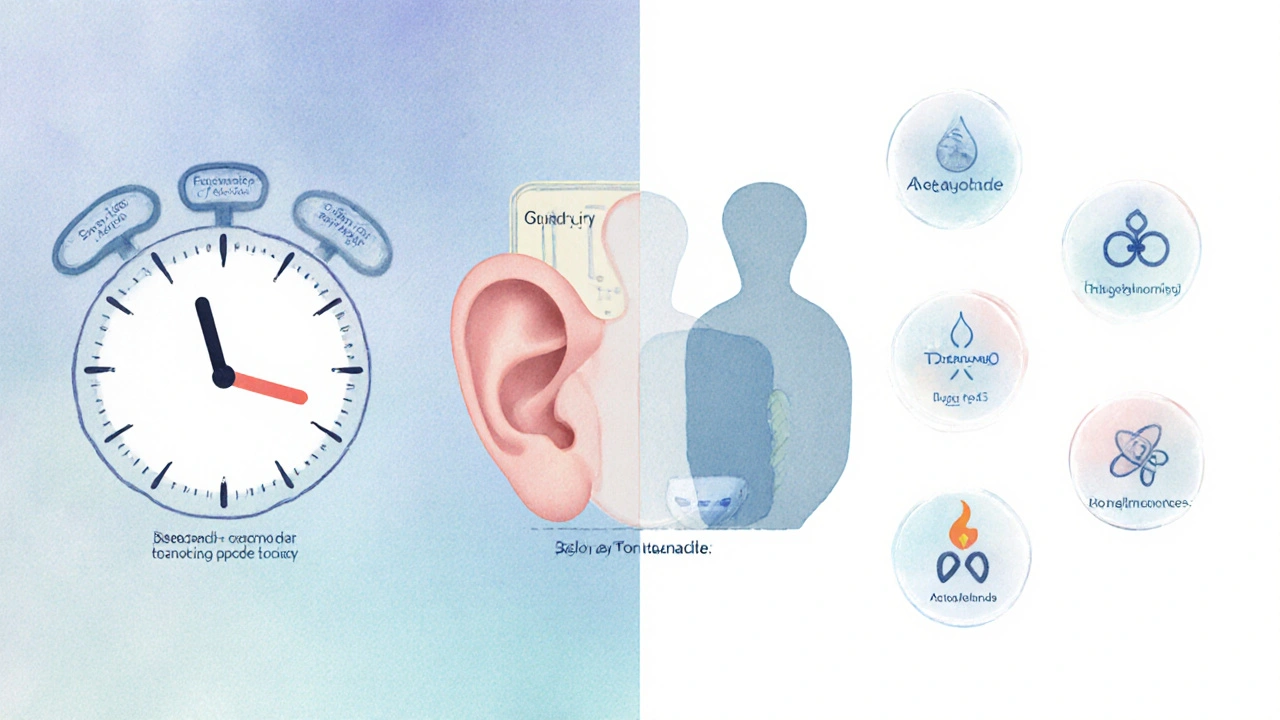Lasix (Furosemide) vs. Other Loop Diuretics: A Detailed Comparison
 Oct, 5 2025
Oct, 5 2025
Loop Diuretic Comparison Tool
- Onset of Action: How quickly the diuretic begins working after administration
- Duration: How long the effect lasts before needing another dose
- Potency: Effectiveness relative to furosemide (1x)
- Cost: Monthly price estimates in AUD
- Side Effects: Common and serious adverse effects to monitor
Key Takeaways
- Lasix is the most widely prescribed loop diuretic, but alternatives like torsemide and bumetanide can be more potent or better tolerated for some patients.
- Onset, duration, and cost vary widely: torsemide works slower but lasts longer, while bumetanide works fast and is inexpensive.
- Side‑effect profiles differ - ethacrynic acid carries a higher risk of hearing loss, whereas potassium‑sparing agents avoid low‑potassium issues.
- Choosing the right diuretic depends on kidney function, electrolyte balance, dosing convenience, and insurance coverage.
- Always check for drug interactions; many diuretics amplify the effects of ACE inhibitors, NSAIDs, and certain antibiotics.
When doctors need to get rid of excess fluid - whether it’s from heart failure, liver cirrhosis, or kidney disease - they often reach for a loop diuretic. Furosemide is the generic name, while Lasix is the brand most people recognize. But Furosemide isn’t the only game in town. Below we break down how it stacks up against the most common alternatives, so you can see which drug fits your health needs and budget.
What is Lasix (Furosemide)?
Furosemide is a high‑potency loop diuretic that blocks the Na‑K‑2Cl transporter in the thick ascending limb of the loop of Henle. By doing so, it forces the kidneys to excrete sodium, chloride, and water, leading to rapid fluid loss. It was first approved in the United States in 1966 and quickly became a cornerstone for treating edema and hypertension.
Typical oral doses range from 20mg to 80mg daily, while intravenous dosing can start at 20mg and be titrated based on response. Its peak effect appears within 30‑60minutes after oral ingestion, and the diuretic effect can last up to 6hours.
How Loop Diuretics Work
All loop diuretics share the same basic mechanism: they inhibit the Na‑K‑2Cl symporter, which is responsible for reabsorbing about 25% of filtered sodium. This blockage creates a cascade - reduced medullary osmolarity, diminished water reabsorption, and increased urine output. Because they act early in the nephron, loop diuretics are more powerful than thiazides or potassium‑sparing agents.
Key pharmacokinetic factors that differentiate one loop diuretic from another include:
- Onset of action: how quickly the drug starts producing diuresis.
- Duration: how long the effect lasts after a single dose.
- Bioavailability: proportion of the oral dose that reaches systemic circulation.
- Potency: milligram‑to‑milligram effectiveness compared to furosemide.

Major Alternatives Overview
Below are the most frequently prescribed alternatives, each with its own strengths and drawbacks.
Torsemide is a loop diuretic introduced in the 1990s. It boasts a longer half‑life than furosemide, giving a smoother diuretic curve and better once‑daily dosing for many patients.
Bumetanide is roughly 40times more potent than furosemide on a milligram basis. It’s often chosen for patients who need strong diuresis but can’t tolerate high furosemide doses.
Ethacrynic Acid is unique because it’s the only non‑sulfonamide loop diuretic. This makes it a useful option for patients with sulfa allergies, though it carries a higher risk of ototoxicity.
Acetazolamide belongs to the carbonic anhydrase inhibitor class. While not a loop diuretic, it can be combined with loops for certain glaucoma or altitude sickness scenarios. Its diuretic effect is modest and mainly alkaline urine production.
Spironolactone is a potassium‑sparing diuretic that works on the distal tubule by antagonizing aldosterone. It’s frequently added to loop therapy to counteract potassium loss, especially in heart‑failure patients.
Side‑Effect Profiles at a Glance
All diuretics can cause electrolyte disturbances, but the patterns differ.
- Furosemide: hypokalemia, hyponatremia, ototoxicity at high IV rates.
- Torsemide: similar electrolyte shifts but less frequent ototoxicity.
- Bumetanide: potent potassium loss, occasional skin rash.
- Ethacrynic Acid: higher ototoxicity risk, especially with prolonged high doses.
- Acetazolamide: metabolic acidosis, paresthesia, kidney stone formation.
- Spironolactone: hyperkalemia, gynecomastia in men, menstrual irregularities.
Comparison Table
| Drug | Typical Oral Dose | Onset (oral) | Duration | Potency (vs. Furosemide) | Cost (AU$ per month) | Key Side Effects |
|---|---|---|---|---|---|---|
| Furosemide (Lasix) | 20‑80mg | 30‑60min | 4‑6hr | 1× | ≈$15 | Hypokalemia, ototoxicity |
| Torsemide | 5‑20mg | 60‑90min | 12‑24hr | ≈0.8× | ≈$25 | Less ototoxicity, mild hypokalemia |
| Bumetanide | 0.5‑2mg | 15‑30min | 3‑5hr | ≈40× | ≈$12 | Severe hypokalemia, rash |
| Ethacrynic Acid | 50‑200mg | 30‑60min | 5‑8hr | 1× | ≈$30 | Ototoxicity, allergic reactions |
| Acetazolamide | 250‑500mg | 1‑2hr | 6‑12hr | 0.1× (loop effect) | ≈$10 | Metabolic acidosis, kidney stones |
| Spironolactone | 25‑100mg | 2‑4hr | 12‑24hr | 0.05× (loop effect) | ≈$8 | Hyperkalemia, endocrine side effects |

Decision Criteria: Picking the Right Diuretic
When faced with several options, ask yourself these practical questions:
- What’s the primary goal? Rapid fluid removal (e.g., acute pulmonary edema) favors fast‑acting agents like furosemide or bumetanide.
- How important is dosing convenience? Once‑daily dosing with torsemide can improve adherence for chronic heart failure.
- Do I have a sulfa allergy? Ethacrynic acid avoids sulfonamide structures, but watch for hearing loss.
- What’s my kidney function? Reduced GFR may require lower doses and closer monitoring of electrolytes.
- How does my insurance cover these drugs? Generic furosemide and bumetanide are usually cheapest, while torsemide and ethacrynic acid may need prior authorization.
Pros and Cons Summary
- Furosemide: Proven track record, cheap, fast onset. Cons - short duration, higher ototoxicity risk at IV doses.
- Torsemide: Longer action, smoother diuretic effect, less frequent dosing. Cons - slightly pricier, slower onset.
- Bumetanide: Very potent, useful when high furosemide doses fail. Cons - small dose size can cause dosing errors, strong potassium loss.
- Ethacrynic Acid: Only non‑sulfa loop, good for allergies. Cons - ototoxicity, higher cost.
- Acetazolamide: Useful adjunct for alkaline urine, altitude sickness. Cons - weak diuretic, metabolic acidosis.
- Spironolactone: Prevents hypokalemia, improves survival in heart failure. Cons - can cause hyperkalemia, hormonal side effects.
Safety Tips & Drug Interactions
Diuretics love to team up with other meds, but that can be dangerous if you’re not careful.
- ACE inhibitors or ARBs: Together they boost blood‑pressure control but also heighten the risk of renal impairment and high potassium (especially with spironolactone).
- NSAIDs: May blunt the diuretic response and worsen kidney function.
- Digoxin: Low potassium from loops raises digoxin toxicity risk - monitor levels.
- Antibiotics like aminoglycosides: Add ototoxic potential when paired with furosemide or ethacrynic acid.
- Alcohol: Can increase dehydration - keep intake moderate.
Always have your pharmacist check for interactions before starting a new diuretic, and schedule regular labs (electrolytes, creatinine, BUN) especially after dose changes.
Frequently Asked Questions
Can I switch from furosemide to torsemide without a doctor’s order?
No. Although torsemide is similar, it has a different dosing schedule and potency. A clinician must calculate the equivalent dose and monitor electrolytes.
Why do some patients develop hearing loss on furosemide?
High‑dose intravenous furosemide can damage the inner ear's hair cells, especially when given rapidly. Slower infusions and keeping serum levels below 0.5mg/mL reduce the risk.
Is bumetanide safe for patients with a sulfa allergy?
Bumetanide is a sulfonamide derivative, so it can still trigger reactions in sensitive individuals. Ethacrynic acid is the safer non‑sulfa alternative.
How often should electrolytes be checked after starting a loop diuretic?
For the first two weeks, weekly labs are advisable. Once stable, most clinicians shift to monthly or quarterly monitoring, depending on kidney function and dosage.
Can I use spironolactone together with furosemide?
Yes, combining a loop with a potassium‑sparing agent is common in heart‑failure treatment. The key is to watch potassium levels closely to avoid hyperkalemia.
april wang
October 5, 2025 AT 16:56When you dive into the world of loop diuretics, the first thing to appreciate is the sheer variety of pharmacokinetic profiles each agent offers, which can dramatically influence clinical decision‑making. First, furosemide’s rapid onset of action, typically within 30‑60 minutes, makes it a go‑to for acute pulmonary edema, yet its relatively short duration of 4‑6 hours often necessitates multiple daily dosing. By contrast, torsemide provides a smoother diuretic curve lasting up to 24 hours, allowing many practitioners to prescribe once‑daily regimens that improve adherence. Bumetanide, although only available in microgram doses, boasts a potency roughly 40 times that of furosemide, which can be a lifesaver for patients who are refractory to higher furosemide doses. Ethacrynic acid, being a non‑sulfonamide, is uniquely positioned for individuals with sulfa allergies, but its ototoxic potential demands careful monitoring, especially with high‑dose IV infusions. Acetazolamide, while not a true loop diuretic, serves niche roles such as managing metabolic alkalosis and certain types of glaucoma, and its weaker loop effect makes it unsuitable as monotherapy for volume overload. Spironolactone, a potassium‑sparing agent, is frequently added to loop therapy to counteract hypokalemia and has proven mortality benefits in heart failure, albeit at the cost of possible endocrine side effects like gynecomastia. Cost considerations also play a pivotal role; generic furosemide and bumetanide typically sit at the lower end of the price spectrum, whereas torsemide and ethacrynic acid may require prior authorization and can be substantially pricier. Electrolyte monitoring cannot be overstated; while all loops risk hypokalemia and hyponatremia, the severity varies, with bumetanide often causing the most profound potassium depletion. Drug interactions further complicate therapy-ACE inhibitors and ARBs can amplify renal effects, NSAIDs may blunt diuresis, and aminoglycosides increase ototoxic risk, especially when paired with furosemide or ethacrynic acid. Patient-specific factors such as baseline renal function, comorbidities, and lifestyle preferences ultimately guide the optimal diuretic selection. In practice, many clinicians start with furosemide for its familiarity and cost, then titrate to torsemide or consider bumetanide if response wanes. Finally, remember that regular lab follow‑up, patient education on signs of electrolyte imbalance, and a collaborative approach with pharmacists can safeguard against adverse outcomes while maximizing therapeutic efficacy.
Vishnu Raghunath
October 6, 2025 AT 15:10Wow, another glorified spreadsheet of drug numbers. It's like reading a cafeteria menu for the medically inclined. Who even cares about the exact onset when you can just eyeball the dosage? The whole thing feels like a conspiracy to keep us guessing.
Lin Zhao
October 7, 2025 AT 13:23Thanks for the thorough breakdown! 😊 It's really helpful to see the side‑effect differences laid out side by side. I especially appreciate the note on ototoxicity for ethacrynic acid. Makes the choice a bit clearer for patients with sulfa allergies.
Laneeka Mcrae
October 8, 2025 AT 11:36First off, the table is spot on for quick reference. Furosemide's cheap price makes it the default, but don't overlook torsemide's longer duration for chronic management. If a patient keeps coming back with low potassium, think about swapping to bumetanide or adding a potassium‑sparing agent. Ethacrynic acid should be a last resort unless there's a proven sulfa allergy. Also, keep an eye on hearing tests when using high IV doses of any loop.
Kendra Barnett
October 9, 2025 AT 09:50Great points about potency and cost. I’ve seen patients switch from furosemide to torsemide and notice better adherence. Just remember to adjust the dose when you make the change.
Warren Nelson
October 10, 2025 AT 08:03Loop diuretics are a balancing act. You want enough volume removal without tripping the electrolyte alarm. I usually start low, watch the labs, and then titrate up. It saves a lot of trouble down the road.
Abby Elizabeth
October 11, 2025 AT 06:16This article is just a boring spreadsheet.
Mark Haycox
October 12, 2025 AT 04:30Americans think they invented diuretics, lol. They forget the rest of the world actually uses more torsemide because furose is cheap but outdated. Also, the ototoxicity scares are overblown when you give it right.
Michael Taylor
October 13, 2025 AT 02:43Interesting data, but let's be real!
We love these charts because they look professional, yet the real world is messy!
Patients forget to take meds, labs are delayed, and doctors still argue about potency!
So while the numbers are neat, the practice is chaotic!
Stay vigilant!
Troy Brandt
October 14, 2025 AT 00:56From a pharmacology perspective, the Na‑K‑2Cl symporter inhibition is a fascinating target. The differences in bioavailability between the agents can shift the dosing frequency dramatically. For instance, torsemide's higher oral bioavailability means less drug is needed to achieve the same diuretic effect as furosemide. Moreover, the protein binding profiles influence the duration of action, with torsemide having a longer half‑life. Clinicians should also consider the impact on the renin‑angiotensin‑aldosterone system, especially when combining with ACE inhibitors. Finally, the cost factor, while often overlooked, can affect patient adherence and ultimately outcomes.
Callum Smyth
October 14, 2025 AT 23:10Great summary! 😃 The table really helps when you’re discussing options with patients. I’ve found that explaining the onset and duration in plain language reduces confusion. Also, the cost estimates are useful for those without insurance.
Thomas Burke
October 15, 2025 AT 21:23Glad you mentioned patient education. It's key to help them understand why labs are needed. Also, dosage adjustments can be simple if they know the basics.
Debbie Frapp
October 16, 2025 AT 19:36Love how the post breaks down each drug's pros and cons. The side‑effect section is spot on; I always double‑check potassium levels after starting a loop. Also, the note on hearing loss is a good reminder for IV dosing.
Michelle Abbott
October 17, 2025 AT 17:50From a pharmacodynamics viewpoint, the differential affinity for the Na‑K‑2Cl cotransporter is pivotal. Ethacrynic acid's non‑sulfonamide structure confers a unique binding kinetic, which might explain its heightened ototoxic profile. Furthermore, the dose‑response curve of bumetanide illustrates steep potency escalation, demanding precise titration. These nuances are essential for tailoring therapy to individual patient phenotypes.
Nilesh Barandwal
October 18, 2025 AT 16:03The interplay between diuretics and ACE inhibitors is critical. Watch for renal function changes.
Elise Smit
October 19, 2025 AT 14:16Accurate dosing and regular electrolyte monitoring are paramount. Always verify patient adherence before escalating therapy.
Sen Đá
October 20, 2025 AT 12:30It is incumbent upon the prescriber to meticulously evaluate the pharmacokinetic parameters of each loop diuretic before making a therapeutic decision. The potential for adverse effects, particularly ototoxicity, mandates vigilant auditory monitoring, especially in patients receiving high‑dose intravenous regimens. Moreover, the synergistic impact of concomitant nephrotoxic agents must not be underestimated, as it may precipitate acute kidney injury. Consequently, a comprehensive risk‑benefit analysis, grounded in clinical evidence, should guide the selection of the appropriate diuretic class.
Tatiana Akimova
October 21, 2025 AT 10:43Never forget that cost matters! Patients on a tight budget often stick with furosemide despite its drawbacks. If you can afford torsemide, the once‑daily dosing can improve compliance dramatically.
Calandra Harris
October 22, 2025 AT 08:56The data clearly show that torsemide offers a smoother diuretic profile, which can reduce hospital readmissions. Its higher cost is justified by better patient outcomes. Ethacrynic acid should be reserved for rare sulfa‑allergy cases due to its ototoxic risk. Bumetanide's potency makes it ideal for refractory edema, but careful potassium monitoring is essential. Overall, individualizing therapy based on pharmacologic properties and patient factors yields the best results.